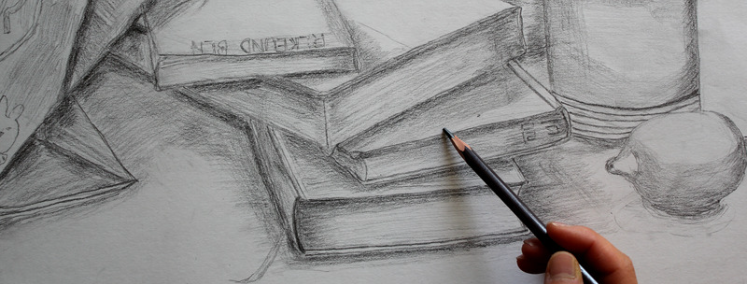

Sketching is a form of drawing that humans have practised for thousands of years. The earliest known sketches were created by prehistoric humans on cave walls, using simple tools such as sticks and charcoal. These sketches often depict hunting scenes, animals, and other aspects of daily life.
As human civilization developed, sketching drawing became more refined and sophisticated. In ancient Egypt, for example, artists used sketches to create preliminary designs for their monumental sculptures and other artworks. These sketches were often done on papyrus or different types of paper.
During the European Renaissance, sketching became an important part of the artistic process. Artists such as Leonardo da Vinci and Michelangelo used sketches to plan their compositions and work out the details of their masterpieces. Drawings from this era were often done with pen and ink or with charcoal on paper.
In the following centuries, sketching drawing continued to evolve as an art form. The development of new technologies, such as graphite pencils and erasers, allowed artists to create more detailed and nuanced sketches. The invention of photography in the 19th century also impacted sketching, as artists began to use sketches to capture the fleeting moments and impressions that the camera could not.
Today, sketching drawing remains an integral part of the artistic process and is practised by artists of all ages and skill levels. From simple doodles in a notebook to detailed, lifelike portraits, sketching is a powerful form of artistic expression.
Sketching is a beautiful way for children to express their creativity and imagination. It can be a relaxing and enjoyable activity that helps them develop their fine motor skills and eye-hand coordination. Sketching drawing can also help children develop their observation and concentration skills, and it can be a fun way to learn about shapes, colors, and other elements of art.
If you're looking for ideas to get your kids started with sketching, here are some fun and simple prompts that can inspire their creativity:
Draw a portrait: Self-portraits are a great way for kids to express themselves and explore their own identity. Also, drawing a portrait of someone they know can be a great way for kids to practice their observation and concentration skills. They can draw the person's face or full body and experiment with different colors and textures.
Draw your favorite animal: Kids love animals, and drawing their favorite animal can be a great way to explore different shapes and textures. Encourage them to experiment with different colors and patterns.
Draw a scene from nature: Nature is full of interesting shapes and colors, and it can be a great source of inspiration for young artists. They can draw a landscape, a tree, a flower, or any other natural element that catches their eye.
Draw a still life: A still life is a drawing of objects that are arranged in a composition. It can be a fun challenge for kids to arrange objects in a pleasing way and then draw them. They can use everyday objects like fruit, toys, or household items.
Draw your favorite book character: Kids love books, and drawing their favorite book character can be a fun way to bring a story to life. They can draw the character in action or create a new scene for the character.
Draw a cartoon: Cartoons are a great way for kids to experiment with different shapes and expressions. They can create their own cartoon character or draw a favorite cartoon character from a TV show or movie.
Draw a cityscape: A cityscape is a drawing of a city or urban area. Kids can draw buildings, cars, people, and other elements of city life. Encourage them to experiment with different perspectives and angles.
Draw a fantasy creature: Fantasy creatures like dragons, unicorns, and monsters are always popular with kids. They can draw their own creature or create a scene with an existing creature.
Draw a scene from your favorite movie or TV show: Kids love movies and TV shows, and drawing a scene from a favorite show can be a fun way to bring it to life. They can draw characters, props, and backgrounds to create a scene.
Once your child has chosen a subject to draw, here are some tips to help them get started:
Start with basic shapes: Encourage your child to start with simple shapes like circles, triangles, and squares to create the basic structure of their drawing. They can then add details and refine the shape as they go.
Experiment with different materials: Sketching drawing can be done with a wide variety of materials, including pencils, markers, crayons, and even digital tools. Encourage your child to experiment with different materials to find what they enjoy the most.
Practice observation: Sketching drawing requires careful observation of the subject being drawn. Encourage your child to take their time and really look at the subject before starting to draw.
Practice shading: Shading is the technique of adding depth and dimension to a drawing by using different values of the same color. Encourage your child to experiment with shading to create more realistic and interesting drawings.
If your kid is interested in beginning to sketch, there are a few things you can do to get started.
Steps to Start Sketching
Gather Materials
Before you can begin sketching drawing, you'll need to gather the right materials. You'll need a sketchbook or some paper, a pencil, and an eraser. Some people also like to use other materials, such as charcoal or pastels, but these aren't necessary for beginners.
Choose Your Subject
Once you have your materials, you'll need to choose a subject to sketch. This could be anything that interests you, from a flower to a building to a person. It's a good idea to start with something simple, like a household object or a pet, and work your way up to more complex subjects.
Set Up Your Workspace
Next, you'll need to set up your workspace. Find a quiet, well-lit space where you can work without distractions. Make sure your materials are within easy reach, and arrange them in a way that feels comfortable to you.
Start Sketching
Now it's time to start sketching! Begin by making some loose, light marks on your paper to get a feel for the subject. Don't worry about making mistakes at this point – the goal is simply to get comfortable with the materials and the subject.
Refine Your Sketch
Once you've made some initial marks, start refining your sketch. Use darker lines to add more detail and depth, and make corrections as you go. Remember that sketching is a process, and it's okay to make mistakes and go back and fix things.
Learn Sketching with us!
Easy Steps to draw a Pikachu Sketch
Tips and Tricks to Make Amazing Sketches
Practice, Practice, Practice
The best way to improve your sketching skills is to practice regularly. Try to set aside a little time each day to work on your sketches, even if it's just for a few minutes.
Observe Carefully
One of the keys to successful sketching is careful observation. Take the time to really look at your subject, noticing its shape, texture, and details.
Use Different Pencils
Different pencils have different levels of hardness, which affects the texture and darkness of your lines. Experiment with different pencils to see which ones work best for you.
Experiment with Different Materials
Don't be afraid to try out different materials, such as charcoal, pastels, or even digital tools. Each material has its own unique properties, and experimenting with different materials can help you find new ways to express yourself.
Don't Be Afraid to Make Mistakes
Sketching is a process, and making mistakes is a natural part of that process. Don't be too hard on yourself if your sketch doesn't turn out exactly as you had hoped. Instead, use your mistakes as an opportunity to learn and grow.
Now that you have gathered all the information about the sketches, here are famous sketches that exist around the world. Each sketch has its own unique story and significance, and together they demonstrate the incredible diversity and richness of the world of art.
The Vitruvian Man by Leonardo da Vinci - This sketch, created in the late 15th century, depicts a man in two superimposed positions, with his arms and legs spread out in a circle and a square. The sketch is based on the work of the ancient Roman architect Vitruvius, who believed that the human body was the perfect embodiment of mathematical proportions.
The Sistine Chapel Ceiling by Michelangelo - This sketch, created in the early 16th century, depicts scenes from the Book of Genesis in a series of panels on the ceiling of the Sistine Chapel in Rome. The sketch is known for its intricate detail and lifelike depictions of human figures.
The Night Watch by Rembrandt - This sketch, created in the mid-17th century, depicts a group of soldiers and officers from a Dutch militia group. The sketch is notable for its dramatic use of light and shadow, which creates a sense of depth and movement in the composition.
The Mona Lisa by Leonardo da Vinci - This sketch, created in the early 16th century, is perhaps the most famous portrait in the world. The sketch depicts a woman with a mysterious smile, and is known for its use of sfumato, a technique that involves blending colors and tones to create a soft, smoky effect.
The Great Wave off Kanagawa by Hokusai - This sketch, created in the early 19th century, is one of the most famous examples of Japanese art. The sketch depicts a massive wave about to crash down on a boat, and is known for its use of color and line to create a sense of movement and power.
The Persistence of Memory by Salvador Dali - This sketch, created in the early 20th century, depicts a surreal landscape with melting clocks and other bizarre objects. The sketch is known for its use of surrealism, a movement that sought to explore the subconscious mind and challenge traditional notions of reality.
Facts About Sketching
Sketching has been around for thousands of years. Some of the oldest known sketches are from prehistoric cave paintings! Famous artists such as Leonardo da Vinci and Michelangelo were known for their amazing sketches. They used sketches to plan out their paintings and sculptures.
Sketching is used in many different industries, from fashion design to architecture to video game development. There are many different styles of sketching, including realism, caricature, and manga.
Overall, sketching is a versatile and powerful tool that can be used in many different ways to enhance creativity, communication, and understanding. Whether you are a professional artist or just starting out, there are endless possibilities for exploration and discovery through sketching. In conclusion, sketching is a wonderful activity with many benefits for children and adults alike. From developing fine motor skills and boosting creativity to enhancing observation skills and concentration, sketching can benefit those who practice it.
If you're interested in learning more about sketching or want to improve your skills, we encourage you to take sketching classes with TalentGum Online Art and Craft Classes. Our experienced instructors can help you develop your skills and explore new techniques and styles of drawing. Whether you're a beginner or an experienced artist, we have classes to help you take your sketching to the next level.
So why wait? Join us at TalentGum today and start your journey to becoming a skilled and confident sketch artist!
BOOK A FREE DEMO – HERE
We will send you a confirmation code
 + 91
+ 91
We will send you a confirmation code

Have trouble signing in? Use Email Address instead.
Don't have an account? Click here to Sign Up.
Almost There: Enter Your Details and Select Your Preferred Time
